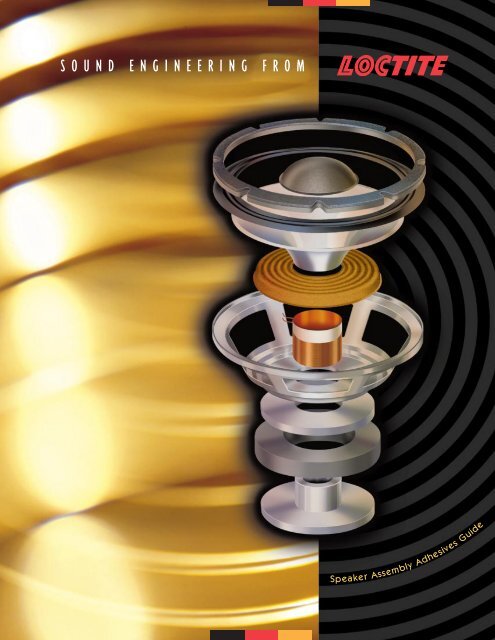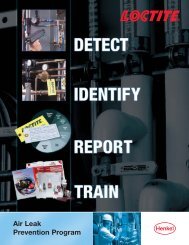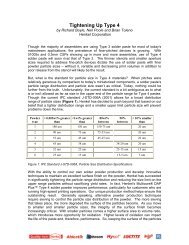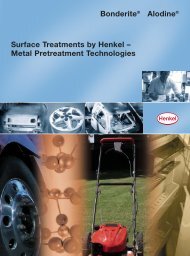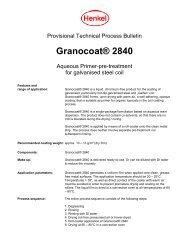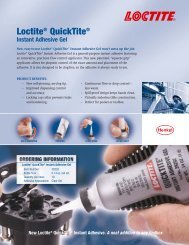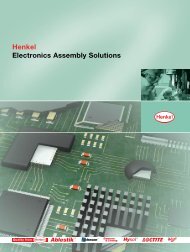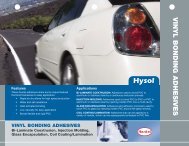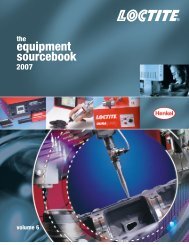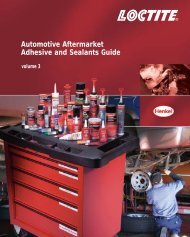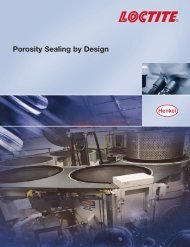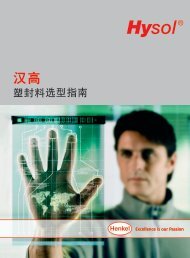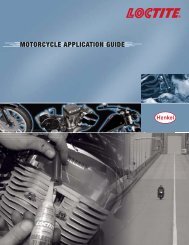SOUND ENGINEERING FROM - Loctite.ph
SOUND ENGINEERING FROM - Loctite.ph
SOUND ENGINEERING FROM - Loctite.ph
- No tags were found...
You also want an ePaper? Increase the reach of your titles
YUMPU automatically turns print PDFs into web optimized ePapers that Google loves.
S O U N D E N G I N E E R I N G F R O MSpeakerAssemblyAdhesivesGuide
<strong>Loctite</strong> ® adhesives have been specifiedby the world’s major speaker manufacturersfor over two decades. With themost diversified line of adhesives andsealants in the industry, <strong>Loctite</strong> hasproducts to meet your specific needs.Whether you’re bonding, gasketing,sealing or coating, <strong>Loctite</strong> is the bestresource for speaker application assistance.Adhesives can provide designadvantages, improve overall productperformance, speed assembly time,and increase production efficiency andquality. We can help you get yourspeakers to market — faster and atreduced costs.At <strong>Loctite</strong>, our goal is to become yourproductivity consultant. Our engineersare extensions to your engineeringstaff. Put us on your design team andwe will work closely with you by:• providing and developing productsthat meet your performancerequirements;• giving you the best technical serviceand support in the industry;• providing highly trained and skilledpersonnel who know how totroubleshoot and solve problems;• supplying in-house product andapplication training and support.Using state-of-the-art testing andevaluation facilities in our NorthAmerican Engineering Center, <strong>Loctite</strong>can simulate curing and parts handling,as well as production lineconditions for product applications,providing you with proven solutions.Every member of the <strong>Loctite</strong> teamstands ready to assist you. OurAdhesives & Sealants Specialists makeup the most knowledgeable sales forcein the business. By analyzing individualcustomer applications, they areable to determine which <strong>Loctite</strong> product,process or solution will work bestfor your specific applications. Theywork together with <strong>Loctite</strong> engineers,chemists, and marketing managers todevelop innovative processes to meetcustomer needs, whatever the demand.Put us to the test and put us on yourteam. Call <strong>Loctite</strong> at 1-800-842-0041for technical assistance, or 1-800-323-5106 for the name of your<strong>Loctite</strong> Sales Engineer.
• <strong>Loctite</strong> Speaker Applications . . . . . . . . . . . . . . . . . . . . . . . . . . . . . . . . . . . . . 4• Product Selector Guide . . . . . . . . . . . . . . . . . . . . . . . . . . . . . . . . . . . . . . . 5 - 7• Assembling Speakers with <strong>Loctite</strong> ® Adhesives . . . . . . . . . . . . . . . . . . . . . . 8 - 17Pole Piece to Magnet to Top Plate . . . . . . . . . . . . . . . . . . . . . . . . . . . . . . . . . . . . . . . 8, 9Products for Pole Piece to Magnet to Top Plate AssemblyTop Plate to Frame . . . . . . . . . . . . . . . . . . . . . . . . . . . . . . . . . . . . . . . . . . . . . . . . . . 10Products for Top Plate to Frame AssemblySpider Assembly to Frame . . . . . . . . . . . . . . . . . . . . . . . . . . . . . . . . . . . . . . . . . . . . 11Products for Spider to Frame AssemblyVoice Coil to Spider to Cone . . . . . . . . . . . . . . . . . . . . . . . . . . . . . . . . . . . . . . . . . 12, 13Products for Voice Coil to Spider to Cone AssemblySurround to Frame or Cone . . . . . . . . . . . . . . . . . . . . . . . . . . . . . . . . . . . . . . . . . . . . 14Products for Surround to Frame or Cone AssemblyDust Cap to Cone . . . . . . . . . . . . . . . . . . . . . . . . . . . . . . . . . . . . . . . . . . . . . . . . . . . 15Products for Dust Cap to Cone AssemblyGasket to Surround . . . . . . . . . . . . . . . . . . . . . . . . . . . . . . . . . . . . . . . . . . . . . . . . . 16Products for Gasket to Surround AssemblyDressing Lead Wires to Cone . . . . . . . . . . . . . . . . . . . . . . . . . . . . . . . . . . . . . . . . . . . 17Products for Dressing Lead Wires to Cone Assembly• <strong>Loctite</strong> ® Product, Ordering and Technical Information . . . . . . . . . . . . . . . . 18 - 30SPEEDBONDER and Structural Adhesives . . . . . . . . . . . . . . . . . . . . . . . . . . . . . . . 18, 19Activators for SPEEDBONDER and Structural Adhesives . . . . . . . . . . . . . . . . . . . . . . . . . . . . 20, 21Cyanoacrylate Adhesives . . . . . . . . . . . . . . . . . . . . . . . . . . . . . . . . . . . . . . . . . . . 22, 23Accelerators and Primers for Cyanoacrylates . . . . . . . . . . . . . . . . . . . . . . . . . . . . . . 24, 25Light Cure Adhesives . . . . . . . . . . . . . . . . . . . . . . . . . . . . . . . . . . . . . . . . . . . . . . 26, 27Epoxy Adhesives . . . . . . . . . . . . . . . . . . . . . . . . . . . . . . . . . . . . . . . . . . . . . . . . . 28, 29Other <strong>Loctite</strong> Adhesives . . . . . . . . . . . . . . . . . . . . . . . . . . . . . . . . . . . . . . . . . . . . . . 30Table of Contents• <strong>Loctite</strong> ® Dispensing and Cure Systems . . . . . . . . . . . . . . . . . . . . . . . . . . . 31 - 33Epoxy Dispensing Systems & Accessories. . . . . . . . . . . . . . . . . . . . . . . . . . . . . . . . . . . 31Manual Dispensing Systems. . . . . . . . . . . . . . . . . . . . . . . . . . . . . . . . . . . . . . . . . . . . 32Semi-Automatic Dispensing Systems. . . . . . . . . . . . . . . . . . . . . . . . . . . . . . . . . . . . . . 32Fully Automatic Dispensing Systems . . . . . . . . . . . . . . . . . . . . . . . . . . . . . . . . . . . . . . 32Light Cure Systems . . . . . . . . . . . . . . . . . . . . . . . . . . . . . . . . . . . . . . . . . . . . . . . . . 33• Glossary of Terms . . . . . . . . . . . . . . . . . . . . . . . . . . . . . . . . . . . . . . . . . . . . . . . . . 34 - 353
LOCTITE PRODUCT SELECTOR GUIDESpeaker Applications Recommended Products Package Sizes Order # Key Product Features324 SPEEDBONDER Adhesive 1 50 ml Bottle 32430 Medium viscosity, high impact resistant structural acrylic.1 liter Bottle 32490326 SPEEDBONDER Adhesive 2 50 ml Bottle 32629 Fast fixturing, medium viscosity structural acrylic.1 liter Bottle 32685Pole Pieceto Magnetto Top PlateTop Plateto FrameVoice Coilto Spiderto Cone332 Structural Adhesive 3 25 ml Syringe 33201 High thermal, shock and impact resistance; structural acrylic paste.300 ml Cartridge 332751 liter Bottle 3329012 liter Pail 17601392 Structural Adhesive 3 25 ml Syringe 39205 Ultra fast fixturing, thermally resistant structural acrylic paste.50 ml Bottle 39250300 ml Cartridge 392751 liter Bottle 3928015 liter Pail 175073270 Structural Adhesive 2 1 liter Bottle 12035 Low viscosity, fast fixturing structural acrylic.15 liter Pail 18614BLACK MAX ® 380 3 gm Tube 38004 Low viscosity for small gaps; toughened black cyanoacrylate.1 oz Bottle 380501 lb Bottle 380612 kg Bottle 18494PRISM ® 410 3 gm Tube 41004 Medium viscosity; toughened, black cyanoacrylate.20 gm Bottle 410451 lb Bottle 410612 kg Bottle 41088BLACK MAX ® 380 3 gm Tube 38004 Low viscosity; toughened, black cyanoacrylate.1 oz Bottle 380501 lb Bottle 380612 kg Bottle 18494PRISM ® 410 3 gm Tube 41004 Medium viscosity; toughened, black cyanoacrylate.20 gm Bottle 410451 lb Bottle 410612 kg Bottle 41088<strong>Loctite</strong> Product Selector GuidePRISM ® 411 3 gm Tube 41104 Medium viscosity; clear, toughened cyanoacrylate.20 gm Bottle 411451 lb Bottle 411612 kg Bottle 41191SUPER BONDER ® 422 1 oz Bottle 42250 Gap filling; general purpose cyanoacrylate.2 kg Bottle 42261PRISM ® 498 1 oz Bottle 49850 Thermally resistant, clear, medium viscosity cyanoacrylate.1 lb Bottle 498611 4 Use with Activator 7075Made to order2 5 Use with Activator 7090,7091, or 7649 Not a distributor stock item.3 Use with Activator 7380 or 7387LOCTITE PRODUCT SELECTOR GUIDE continued on next page5
Speaker Applications Recommended Products Package Sizes Order # Key Product FeaturesPRISM ® 4204 20 gm Tube 26324 Medium viscosity; thermally resistant cyanoacrylate.1 lb Bottle 26325PRISM ® 4210 3 gm Tube 19757 Thermally resistant, black, low viscosity cyanoacrylate.20 gm Bottle 197581 lb Bottle 197592 kg Bottle 19760 4<strong>Loctite</strong> Product Selector GuideVoice Coilto Spiderto Cone(continued)Spider Assemblyto FramePRISM ® 4211 3 gm Tube 19761 Thermally resistant, black, high viscosity cyanoacrylate.20 gm Bottle 197621 lb Bottle 19763 .2 kg Bottle 19764 4DURABOND E-20HP 50 ml Dual Cartridge 29314 High performance, off-white toughened epoxy with high peel200 ml Dual Cartridge 29315 and shear strength; 20 minute worklife.400 ml Dual Cartridge 293165 gallon Pail, Resin 29317 45 gallon Pail, Hardener 29318 4DURABOND E-60HP 50 ml Dual Cartridge 29319 High performance, off-white toughened epoxy with high peel200 ml Dual Cartridge 29320 and shear strength; 60 minute worklife.400 ml Dual Cartridge 293215 gallon Pail, Resin 29322 45 gallon Pail, Hardener 29323 4DURABOND E-120HP 50 ml Dual Cartridge 29353 High performance, non-sag, amber, high strength epoxy;200 ml Dual Cartridge 29354 120 minute worklife.400 ml Dual Cartridge 293555 gallon Pail, Resin 29356 45 gallon Pail, Hardener 29357 4PRISM ® 401 3 gm Tube 40104 Low viscosity, ultra fast fixturing cyanoacrylate.20 gm Bottle 401401 lb Bottle 401612 kg Bottle 17738PRISM ® 410 3 gm Tube 41004 Medium viscosity, toughened black cyanoacrylate.20 gm Bottle 410451 lb Bottle 410612 kg Bottle 41088PRISM ® 401 3 gm Tube 40104 Ultra fast fixturing, low viscosity cyanoacrylate.20 gm Bottle 401401 lb Bottle 401612 kg Bottle 17738Surroundto Frameor ConePRISM ® 403 3 gm Tube 40304 Low odor/low blooming, medium viscosity cyanoacrylate.1 oz Bottle 403401 lb Bottle 403612 kg Bottle 40390PRISM ® 410 3 gm Tube 41004 Medium viscosity, black toughened cyanoacrylate.20 gm Bottle 410451 lb Bottle 410612 kg Bottle 41088PRISM ® 411 3 gm Tube 41104 Clear, toughened, high viscosity cyanoacrylate.20 gm Bottle 411451 lb Bottle 411612 kg Bottle 411916
Speaker Applications Recommended Products Package Sizes Order # Key Product FeaturesPRISM ® 401 3 gm Tube 40104 Low viscosity, ultrafast fixturing cyanoacrylate.20 gm Bottle 401401 lb Bottle 401612 kg Bottle 17738PRISM ® 410 3 gm Tube 41004 Black, toughened, medium viscosity cyanoacrylate.20 gm Bottle 410451 lb Bottle 410612 kg Bottle 41088Dust Capto ConeSUPER BONDER ® 422 1 oz Bottle 42250 Gap filling; general purpose cyanoacrylate.1 lb Bottle 422613106 25 ml Syringe 23697 Fast & flexible UV/V light cure acrylic.1 liter Bottle 2369815 liter Pail 246743175 25 ml Syringe 29505 Ultra clear UV cure acrylic; fast tack-free surface cures.1 liter Bottle 2950615 liter Pail 29507PRISM ® 4204 20 gm Tube 26324 Handles 250°F continuous; high viscosity cyanoacrylate.1 lb Bottle 26325FLASHCURE 4303 4 oz kit 29577 5 Light cure cyanoacrylate; surface cure in
Assembling Speakers with <strong>Loctite</strong> ® AdhesivesPole Piece to Magnet to Top PlateThe three essential components bonded in the magnetassembly are the magnet itself (most commonlyceramic ferrite rings) and either a T-yoke, whichincludes a pole piece, or a plate and pole combination,and a top plate, or washer, made of steel. The T-yoke(referred to as the back plate, end plate or pole andplate) is bonded onto one face of the magnet, and thetop plate (referred to as the washer or front plate) isbonded to the other face.To achieve consistent bonding performance, matingsurfaces must be clean. Steel parts may be contaminatedwith plating residues, or lubricants, and the natureof the problem varies with the production process. Aby-product of the Blanchard grinding process thatmakes magnet faces smooth and parallel, is a coating offine dust which should be cleaned from the matingsurface before bonding, using a damp cloth. If any otherresidues are suspected, the mating surfaces of the partsshould be cleaned with isopropyl alcohol or acetone.Bonding the magnet assembly together is oftenaccomplished with two-part epoxy adhesives, especiallyin Asia, where the adhesive is widely known as"A/B glue". When mixed properly at a 1:1 ratio, the resultingadhesive is typically gray. A combination of poor orabsent mixing technique (running two beads over eachother), and assembly line workers failing to rotate theparts while pressing them together, is a recipe for disaster.This approach requires that the operator dispensethe correct ratio by eye, which may be difficult withcomponents of differing viscosities. An emerging trend isthe use of static mix nozzles or equipment to obtaina more consistent, reliable method.Cyanoacrylates have been used for magnet and steelassembly in small and specialized drivers, and althoughthey can be very fast, their long term bond strengthto ceramic materials remains questionable. The successof the method suggests that in low stress applications,a rubber toughened cyanoacrylate may provide thedesired performance. Occasionally, cyanoacrylatesare used to tack parts together quickly, in combinationwith structural acrylics to insure the needed long termdurability.Current thinking on magnet to steel bonding runsin favor of structural acrylic adhesives, with severalvariations formulated for different surfaces, gap fillcapability and fixture times. These structural adhesivesare economical, fast, strong, easily dispensed, and createthin bondlines to minimize magnetic energy losses.<strong>Loctite</strong> ® structural acrylics develop good handlingstrength in 30 to 90 seconds, which allows the magnetassembly to be magnetized within 5 minutes of assembly.This speed of fixture also allows the magnetassembly to be placed briefly into a clamp, where it canbe pressed to create a very thin and uniform bondline.This extra step can be beneficial in high performancedrivers and compression drivers, where tolerances mustbe very tight. Structural acrylics are used with primers,and the latest solventless primers for dichromatedsurfaces can bond to steel that has been dichromated,or plated with clear, black or yellow zinc.8
Ideally, the adhesive should not be applied over apainted surface, as the bond between the paint and thesubstrate can limit overall bond strength. Activators foracrylics or any other adhesives, should be applied onlyonto the steel parts (at room temperature), so that thecarrier solvents in the activator can evaporate entirelybefore assembly. Since ceramic magnets are quiteporous, the activator applied to them can wick deepbelow the surface. So while appearing to be dry on thesurface and ready for bonding, the magnet may stillbe loaded with solvents. Trapped solvents maysignificantly slow the cure, and can weaken the ultimatebond strength.A note about the use of Ferrofluids. Ferrofluids arecoloidal suspensions of magnetic particles in an oil-likecarrier liquid, and provide improved thermal transmissionfrom the voice coil to the surrounding steel parts.Since the fluid is magnetic, it remains in the gap, completelyenveloping the voice coil, and any fluid migration(by wicking or splashing) onto nearby bondlines mustbe avoided. Ferrofluidics Corporation (603-883-9800) hasevaluated loudspeaker assembly adhesives for compatibilitywith their fluids, and has approved many <strong>Loctite</strong> ®adhesives as fully compatible.The <strong>Loctite</strong> adhesives typically used in speakerassembly do not effect, nor are effected by, incidentalcontact with Ferrofluids, once fully cured. However,uncured acrylic adhesives are known to have catastro<strong>ph</strong>iceffects upon Ferrofluids if they come into contact,causing the magnetic fluid viscosity to rise dramatically.Since <strong>Loctite</strong> ® structural acrylics are anaerobic(curing in the absence of oxygen), any excess adhesiveoutside the bondline will not cure, and will remain hazardousto Ferrofluid.Other Types of MagnetsAlong with tremendous magnetic density, Neodymium-iron-boron(NdFeB) magnets have introducedanother unwelcome feature, rapid corrosion. The qualityof the protective coatings can be a significant problemwith these magnets, depending on their source.Neodymium magnets are currently available witha variety of surface treatments such as: 1) vapordeposited aluminum, 2) electro-plated nickel, 3) electrodepositedepoxy paint, and 4) plasma depositedtitanium-nitride. Each of these coatings requires specialconsideration. Neodymium magnets should be inspectedclosely before assembly operations begin, and thosethat show oxidation should be discarded. Bonding toalready oxidized surfaces will neither create a strongbond, nor inhibit further corrosion.Neodymium, samarium-cobalt and alnico magnetsgenerally use a "pot and pole-tip" topology, rather thantop plate and pole plate. The steel parts involve thesame finishes and the adhesive recommendations arethe same as for ceramics.Assembling Speakers with <strong>Loctite</strong> ® AdhesivesRecommended products for the Pole Piece to Magnet to Top Plate Assembly:<strong>Loctite</strong> ® SpeedBonder Adhesives 324, 326 or <strong>Loctite</strong> ® Structural Adhesives 332, 392 or 3270.See detailed Product Information on SpeedBonder and Structural Adhesives on pages 18 and 19.9
Assembling Speakers with <strong>Loctite</strong> ® AdhesivesNormal manufacturing process calls for the polepiece and magnet to be assembled in one operation,while the frame and top plate are assembled in aseparate operation. Punched steel frames alwaysinclude a ring of holes which mate with a ring of raisedpins on the top plate, and the parts are swaged togetherin a press. Cast aluminum frames are generally fixed tosteel parts by bolts threaded into the top plate. Thinpaper gaskets are sometimes fitted between the frameand the top plate to prevent buzzing, and to seal the gap,thus avoiding whistling noises. A better solution is a thinTop Plate To Framebead of <strong>Loctite</strong> ® structural adhesive, eliminating gasketinventory, while both sealing and reinforcing the joint.In making frames more attractive, particularly for theautomotive aftermarket, manufacturers have embracedpowder coat finishes on their frames, which introducesome unwelcome bonding challenges. Most of thepowders used in these processes contain epoxiescombined with wax compounds, to create smoother andmore attractive surfaces. However, this wax interfereswith the bond and must be stripped off any bondingsurfaces. Washing these surfaces with solvents such astoluene, xylene or methyl ethyl ketone can significantlyimprove bond strength, although these solvents havefallen out of use in the last few years. Isopropyl alcoholmay be the best alternative.Recommended products for the Top Plate to Frame Assembly:<strong>Loctite</strong> ® Cyanoacrylate Adhesives 380 or 410.See detailed Product Information on Cyanoacrylates on pages 22 and 23.10
Spider Assembly to FrameStrength requirements for this bond vary dramatically.At the low end of the stress scale are drivers usinga small voice coil, with modest cone movement togetherwith a large diameter spider. Under these circumstances,the stress on the bondline is minimal, and the adhesivecan be selected for economy or dispensing ease, or both.At the high stress end of the scale are large coil and largeexcursion drivers, particularly those with smalldiameter spiders. In this type of driver, the adhesives aresubjected to simultaneous shear, cleaving, peel andthermal stresses. The bond must be slightly flexible yetaggressive and durable.Priming the surface of the frame with a <strong>Loctite</strong>cyanoacrylate primer will ensure the quickest possiblebond. A bead of low-viscosity cyanoacrylate, such as 401applied to the edge of the spider, will wick into the bondline,developing good handling strength in about20 seconds. If oversprayed with a <strong>Loctite</strong> ® accelerator,it is even faster. Both adhesive and accelerator make foran almost invisible bondline.Some spiders have a surface coating, such as moldrelease, that can delay or even entirely inhibit the cure ofcyanoacrylates. A simple remedy is to wipe the bore ofthe spider with a <strong>Loctite</strong> ® accelerator, such as 7452. Ifprimers (such as PRISM ® Primer 770 AdhesionPromoter) are being used, they should be applied tosurfaces other than the spider, as they may wick into thefibers and not evaporate fast enough for convenientassembly. The <strong>ph</strong>enolic resins used in manufacturingspiders varies from slightly base to slightly acidic, andthe pH factor can dramatically influence the cure speedof cyanoacrylates.On drivers using plastic frames, the spider to framebond can be accomplished by direct heating of the bondline,causing the plastic to reflow into the spider. This isvery quick and economical, but makes rework of anyQC rejects impractical.Recommended products for the Spider Assembly to Frame:<strong>Loctite</strong> ® Cyanoacrylate Adhesives 401 or 410.See detailed Product Information on Cyanoacrylates on pages 22 and 23.11Assembling Speakers with <strong>Loctite</strong>® Adhesives
Assembling Speakers with <strong>Loctite</strong> ® AdhesivesVoice Coil to Spider to ConeIn most cases, this is considered a single bond,although it is sometimes accomplished in two separatesteps, as two bondlines, and in some cases, uses two differentadhesives. This text assumes the most commonsituation: one step, one bondline, and one adhesive.Cyanoacrylates, or instant adhesives, are the productsof choice, particularly the newer thermal resistantproducts which work well where added temperatureresistance is needed. Cyanoacrylates are fast, simpleand the perfect compliment to high speedmanufacturing lines.Paper cones tend to be very porous, and as theirmoisture content changes, the speed of cure of cyanoacrylateswill change. Very low moisture conditionstend to slow the cure, while very high moistureconditions accelerate it. Variations in paper chemistrycan create pH shifts in the cone, and can affect the speedof cure with cyanoacrylates. <strong>Loctite</strong> ® PRISM ® surfaceinsensitive cyanoacrylates work extremely well, over arange of humidity and pH conditions.No matter how experienced the user is, polypropylenecones always present a bonding challenge.Preparation is the key to success. Polypropylene is adifficult surface to wet since it has very low surfaceenergy, but this characteristic can be overcome withsuitable treatment. Several techniques are in use withinthe loudspeaker industry, including corona discharge,blown plasma arc, flame treating, and the use ofchemical primers to enhance surface energy. Whilechemical primers are the most common technique used,plasma etching can produce extremely high bondstrengths. The plasma technique uses an inert gasRF plasma generator to blow an arc of blue plasma ontothe bond area of the cone. Bonding with cyanoacrylateadhesives must take place within a minute for optimumresults. Some localized cosmetic pitting (dulling) of thesurface is normally evident, so the plasma must beconfined to the bond area only. The final bond strengthobtained with the plasma technique is high, as is thehardware investment.The chemical alternative can be as simple asspraying a <strong>Loctite</strong> ® Polyolefin Primer onto the substrateto be bonded and allowing it to evaporate. Or theprocess might call for pre-cleaning the area with acetoneand then mechanically abrading it. The most effectivehigh speed on-line compatible approach may bemechanical abrasion of the bond area, followedpromptly by an application of <strong>Loctite</strong> Polyolefin Primer.This routine lends itself to simple automation and offersexceptionally high bond strength. The effect of theprimer should not be underestimated, as bond strengthsare often 25 to 40 times higher than those achieved whenusing the same adhesives without primer.The cone-coil-spider bond is probably the mosthighly stressed in any given driver, often subjectedto simultaneous shear and cleaving forces, and alsoelevated temperatures. Attention should be paid to thethermal limit of the adhesive, not only the maximum"peak" temperature rating, but also the time-versus-temperatureinformation, which yields much more usefuldata. <strong>Loctite</strong> ® thermally resistant cyanoacrylates workwell on most known bobbin and collar materials, andtolerate sustained high temperature operation (particularlyproduct 4204) much better than any previous typesof cyanoacrylates. These products offer minimal massand easy dispensing, creating a very strongcone-coil-spider bond. Some have high temperatureresistance plus rubber-toughened properties, allowingthem to take peel and cleaving stresses in stride.One production technique that has proven beneficialis spider to coil pre-fixing. It involves adhesive-fasteningthese parts together off-line, using a simple jig. Becausethe coil and spider subassembly is not built in the driver,it can be inspected to ensure that the spider is perfectlylevel and is seated at the right height on the bobbin.If required, additional reinforcing bonds can be placed.12
Since any gap between the spider and the bobbin hasbeen sealed, there is less risk of cone adhesive migratingdown into the gap during final assembly.Although some recently developed epoxies offergood bonds, they are often too slow for most high speedproduction environments. In production environmentswhere speed is not such a critical factor, such as in batchbuilding, some <strong>Loctite</strong> ® DURABOND epoxies workextremely well. DURABOND epoxies E-20HP, E-60HP orE-120HP are recommended for the most demanding andhighly stressed voice coil bonding applications. Sometake an hour or so at room temperature to achieveenough handling strength to allow meaningful end-of-linetesting. This is usually unacceptable. Epoxy cure timescan generally be reduced by using hot-plug inserts orheat tunnels, making DURABOND E-120HP useful forslow assembly lines and batch production methods.Unfortunately, the chemistry that produces a fast curetypically also seriously compromises other useful qualitiesof the epoxy. Often the fastest epoxies display lowpeel and sheer strengths, brittleness, and a catastro<strong>ph</strong>ictendency to crystallize under repeated thermal cycling.Some single component, frozen epoxies have beenused for the cone-coil-spider bond, but they are morecostly and require special storage in freezers. On theassembly line, the problems of thawing these adhesivesfrom -40°C just before use, contending with their shortpot lifes, and dispensing them from small disposablesyringes, make them impractical.For small drivers, and those where the stresses aremore modest, cyanoacrylates have been used with greatsuccess. In high-frequency and midrange drivers, andmoderate power low-frequency drivers, (typically withcoils under 50mm), cyanoacrylates are ideal. They addminimal mass, create a strong bond quickly, and haveexcellent environmental tolerance. Cyanoacrylate"instant" adhesives work best when the joint involvestwo close-fitting, reasonably parallel surfaces. On lowfrequency drivers, this can be obtained by formingcones with short neck sections that closely parallel thevoice coil, ideally with less than 0.25mm of radialclearance. Gel type cyanoacrylates are available forbonding those speaker parts which have larger gaps orpoorer tolerances. Redesign of the part may be morecost efficient however, because when large gaps must befilled, adhesive consumption can be quite high.Cyanoacrylates can be made to form uniform filletsor wedges, if laid as a heavy bead, and then oversprayedwith accelerator, creating a tidy, quick bond. The lowviscosity versions produce a uniform, cosmeticallyattractive bondline. The rapid cure of these adhesives inthe last few steps on the production line allows driversto be tested within minutes of assembly. Also, when driversare assembled with cyanoacrylates, the frequencyresponse and impedance curves taken at the end of theline are essentially the same as those taken after theadhesive is fully cured. The elimination of off-linestacking reduces space requirements and labor costs,and the improved QA feedback from the test stationallows almost immediate correction of problems.If low viscosity cyanoacrylates are applied and thenoversprayed with an accelerator, the resultant curereaction may be too rapid, which can seriously compromisethe bond strength and create a "popcorn" likeappearance to the adhesive. Typically, low viscositycyanoacrylates are already fast curing and do notrequire acceleration. An over-application of acceleratorcan have the same effect, also creating the "popcorn"like appearance.Assembling Speakers with <strong>Loctite</strong> ® AdhesivesRecommended products for the Voice Coil to Spider to Cone Assembly:<strong>Loctite</strong> ® Cyanoacrylate Adhesives 380, 410, 411, 422, 498, 4204, 4210, or 4211, or<strong>Loctite</strong> ® Epoxy Adhesives E-20HP, E-60HP, or E-120HP.See detailed Product Information on Cyanoacrylates on pages 22 and 23; andEpoxies on pages 28 and 29.13
Assembling Speakers with <strong>Loctite</strong> ® AdhesivesSurround to Frame or ConeThe long bondline and large bond areas in this applicationmay result in moderately high adhesiveconsumption. Thus, most attractive adhesives may bethose that exhibit good bond strength very quickly whenapplied in minimal volume, especially in the productionof low priced or commodity grade loudspeakers.Polyester foam and untreated cloth edges are hygroscopic,and the adhesive cure speed will be influencedby the amount of moisture retained within the part.<strong>Loctite</strong> ® 410 has proven most acceptable for polyesterfoam bonding. It fixtures in approximately five secondswhen the bond is oversprayed with a <strong>Loctite</strong> ® acceleratorsuch as 7113, 712, or 7109. Note that Accelerator 7452should not be used on foam edges, as it is too aggressive.Polyester foam and treated cloth may also bebonded in the same way, but since they may be imperviousto the spray, the accelerator overspray may not bevery effective. Care should be exercised to avoidcreating cosmetic blemishes on the part.Approach attaching rubber edges with some caution,as each of the elastomer families have different characteristics.Adhesive migration may be a cosmetic issue,so consider black or clear adhesives. The stresses on thebondline during use are not especially high, as therubber forms an effective strain relief. There may be hightorque (shear forces) applied by the mounting screwsduring installation of the driver into an enclosure.The recommended surface pre-conditioning for allrubber edges is to wipe the part with 70% isopropylalcohol before bonding. This improves the bondstrength by removing lubricants, plasticizers and moldrelease from the rubber surface.The specific recommendations for bondingsurrounds of IIR (butyl rubber) and NBR (nitrile, orBuna-N rubber) are the same adhesives, but the resultantbond strength is much better with NBR. Since IIR isattacked by some solvents, it may curl up if <strong>Loctite</strong> ®Accelerator 7452 is used, since the carrier solvent isacetone. In this case, <strong>Loctite</strong> ® Accelerator 7113 (heptanebased) should be substituted. Either type of acceleratorworks well with NBR. The need for accelerator pretreatmentof the surround should be evaluated. Someassembly routines rely on the bond remaining pliable fora short period, to allow precise part alignment by hand.Other automated routines require the bond to achievehandling strength in a few seconds.For bonding SBR (styrene-butadiene rubber) edges,<strong>Loctite</strong> ® 401, (used without a primer on the framebondline), is superior. Thermoplastic surrounds such asthose made from Santoprene, Stek TPE-PU (thermoplasticelastomer-polyurethane) and other TPUs all benefitfrom pre-treatment with PRISM ® Primer 770 AdhesionPromoter. The adhesive recommendations are thesame as for conventional rubbers. While EPDMrubber edges are not common, they are occasionallyused, and can be bonded very successfully with <strong>Loctite</strong> ®cyanoacrylate adhesives. The nature of the rubbersuggests that no primer is required.Some attention should be given to weatheringeffects, and both the frame to surround and the surroundto cone bonds should be environmentally testedto ensure a long and trouble-free life for the speaker.Recommended products for the Surround to Frame or Cone Assembly:<strong>Loctite</strong> ® Cyanoacrylate Adhesives 401, 403, 410 or 411.See detailed Product Information on Cyanoacrylates on pages 22 and 23.14
Dust Cap to ConeThese are high volume, low-stress bondlines, andsome consideration must be given to the cosmeticconsequences of adhesive migration. Black or clearadhesives are preferred to bond these paper, felt, plastic,or hot-pressed foam materials to the cone. There areseveral chemistries for this application. Light cureacrylics offer tack-free surfaces and cure-on-commandperformance. New light cure cyanoacrylate 4303 offersthe ability to cure in shadowed areas, with surface curesin
Assembling Speakers with <strong>Loctite</strong> ® AdhesivesGasket to SurroundAs with other bondlines, if drivers are subjected totesting immediately after assembly, cyanoacrylates offerexcellent cure speed, ensuring highly stable and repeatableend-of-line measurements. The use of acceleratorson gasket bonds can allow the drivers to be packagedimmediately after QA testing, without gasket "squirming"problems.Since this is a cosmetically sensitive bondline,consideration should be given to automated adhesiveplacement, which may also minimize the quantity ofadhesive used.Recommended products for the Gasket to Surround Assembly:<strong>Loctite</strong> ® Cyanoacrylate Adhesives 410, 411 or 422.See detailed Product Information on Cyanoacrylates on pages 22 and 23.16
Dressing Lead Wires To ConeTo stress-relieve tinsels on the back of the cone andat the terminals on Low Frequency Drivers, several productswork well. For an extremely fast fixture, <strong>Loctite</strong> ®Light Cure Cyanoacrylate 4303 is the product of choice.This two-part formulation cures in 3-5 seconds, usinglow intensity UV light sources, filling gaps up to 0.75mm.<strong>Loctite</strong> ® 4303 is medium viscosity and flows well intoboth the tinsel lead and the cone surface. The majoradvantage of these adhesives is speed, making leaddressing possible for the first time on a high speedassembly line.An alternative Light Cure Adhesive is an acrylicformulation, <strong>Loctite</strong> ® 3175. Designed to achieve rapidtack-free surface cures when exposed to a low intensityUV light source, this product is also excellent when rapidcure speeds are required.Recommended products for Dressing Lead Wires to Cone Assembly:<strong>Loctite</strong> ® Light Cure Adhesives 4303 or 3175, or<strong>Loctite</strong> ® Cyanoacrylate Adhesive 410.See detailed Product Information on Light Cure Adhesives on pages 26 and 27.See detailed Product Information on Cyanoacrylates on pages 22 and 23.Assembling Speakers with <strong>Loctite</strong> ® Adhesives17
SPEEDBONDER and Structural Adhesives<strong>Loctite</strong> ® Product, Ordering and Technical Information<strong>Loctite</strong> ® SPEEDBONDER and Structural Adhesives were developed for bonding applications requiring tensile,shear, and peel strength combined with maximum impact, stress and shock resistance. These two-part, no-mix acrylicadhesives consist of a resin and an activator. The resin component is a solvent-free, medium to high viscosity liquid.Activators are discussed following this section. SPEEDBONDER 324, 326 and 3270 and Structural Adhesives 332 and392 are specially formulated to provide an optimum balance of speed and strength with ease of application.Speaker Applications:Bonding Pole Piece to Magnet to Top PlateProduct Features & Benefits:• 100% resin, solvent-free adhesives.• Forms high strength bonds to ceramic, ferrite and steel, including dichromated and plated metals.• Two component, no-mix technology. Eliminates pot-life related waste and thickening relatedprocess variations.• Dispensable from original containers with manual, semi-automatic or fully automaticdispensing systems.• Rapid fixture at room temperature. Minimizes work-in-process and line length.• Cure speeds may be tailored with choices of activators and primers on some products.Processing Steps:1. Apply recommended activator/primer (see Activators Chart pg. 21-22) to one or both surface(s)if required. Remove any surface contamination by degreasing prior to activation for optimum results.Note: Solvent based activator/primers must be allowed to dry.2. Apply selected adhesive to the other surface.3. Join surfaces using sufficient force to spread adhesives. Secure the assembly, and allowthe adhesive to fixture before further handling.18
TECHNICAL PRODUCT INFORMATIONProduct Number 324 326 3270 332 392Key Product Features High Impact Resistance Fast Fixturing Low Viscosity, Highest Thermal, Ultra Fast, High Thermal& Large Gap Filling & High Strength, Gap Filling Fast Fixturing, Versatile Impact & Shock Resistance Resistance, Good Gap FillingChemical Type Urethane Methacrylate Ester Urethane Methacrylate Ester Urethane Methacrylate Ester Modified Acrylic Modified AcrylicColor Clear Amber Clear Amber Amber Yellow Paste Tan PasteGap Fill .040" .020" .010" .020" .020"Viscosity cP 17,000 18,000 7,000 200,000 60,000Shear Strength (PSI)* 3,000 2,700 3,500 3,000 2,600Temperature Range -65°F to 275°F -65°F to 225°F -65°F to 225°F -65°F to 400°F -65°F to 300°FCure Speed**Fixture 1 1 /2 minutes 45 seconds 1 minute 1 minute 30 secondsFull 24 hours 24 hours 24 hours 24 hours 24 hoursRecommended 7075 7649/7090/7091 7649/7090/7091 7380/7387 7380/7387Primers/ActivatorsSpecific Gravity 1.11 1.1 1.11 0.97 1.16Technical 324 326 3270 332 392Data Sheet+* Varies with substrates.** Grit Blasted Steel; varies by primer or activator selected.+ For additional technical information, request Technical Data Sheet and Material Safety Data Sheets by calling 1-800-562-8483.Bolded Primer/Activator indicates which was used for this data.ORDERING INFORMATIONProduct Number 324 326 3270 332 39225 ml Syringe 33201 3920550 ml Bottle 32430 32629 39250300 ml Cartridge 33275 392751 liter Bottle 32490 32685 12035 33290 3928015 liter Pail 18614 17601 (12 Liter*) 17507<strong>Loctite</strong> ® Product, Ordering and Technical Information* MTO – Made to Order19
Activators for SPEEDBONDER and Structural Adhesives<strong>Loctite</strong> ® Product, Ordering and Technical InformationActivators are the necessary second component of <strong>Loctite</strong> ® SPEEDBONDER and Structural adhesives. Availablein both solvent-based and solventless versions, activators effect the cure of SPEEDBONDER 324, 326 and 3270, andStructural Adhesives 332 and 392. If the carrier solvent present in the activator solvent dispersion is undesirable, thepure catalyst is available as a solvent-free activator. However, it should be noted that when using a solvent-free activator,a minimum amount of activator should be applied, as excessive activator will detrimentally affect the performanceof the adhesive. Activator is applied to one or both surfaces and the adhesive is applied to the other. Curebegins when the parts are mated.Processing Steps:1. Apply SPEEDBONDER or Structural Adhesive to one (or both, if required) of the substrate surfaces.2. Apply activator to the other surface. Allow activator's carrier solvent to flash off; if using asolventless version parts will remain wet to the touch.3. Mate the two surfaces.4. Catalyst from the activator initiates the polymerization of the resin. Allow fixture strengthto develop before handling.20
TECHNICAL PRODUCT INFORMATIONProduct Number 7649 7075 7090 7091 7380 7387Description Primer N Acrylic Activator Solventless Solventless Activator Solventless Activator Acrylic ActivatorActivator N for Dichromated SurfacesUse with Product # 326, 3270 324 326, 3270 326, 3270 332, 392 332, 392Solvent Carrier Acetone Acetone Solventless Solventless Solventless Heptane/IsopropanolSpecific Gravity 0.79 0.79 1.03 >93 0.97 0.8Flash Point (TCC), °F -4 None >200 >200 >200 25TLV, ppm (ACGIH, TWA) 500 500 None None Cu 0.2mg/m 3 fume 400Cu 1 mg/m 3 dustOn-Part Life 30 days 2 hours 1 hour 1 hour 2 hours 2 hoursTechnical Data Sheet+ 7649 7075 7090 7091 7380 7387+ For additional technical information, request Technical Data Sheet and Material Safety Data Sheets, by calling 1-800-562-8483.ORDERING INFORMATIONProduct Number 7649 7075 7090 7091 7380 73871 oz Bottle 193681.75 oz Bottle 19269 19824 1886125 gm Aerosol Can 213474.5 oz Aerosol Can 21348 22671 210881 qt Can 21349 188621 liter Bottle 12695 18109 (can) 19822<strong>Loctite</strong> ® Product, Ordering and Technical Information1 gallon Can 19266 11476 1990721
<strong>Loctite</strong> ® Product, Ordering and Technical InformationBondingTop Plateto FrameCyanoacrylate Adhesives<strong>Loctite</strong> ® cyanoacrylates, or instant adhesives, are one-part, room-temperature curing adhesives and are availablein a range of viscosities, cure speeds, gap-filling capabilities, and substrate compatibilities. A wide variety ofspecialty formulations with properties tailored to meet challenging speaker assemblies are available. Accelerators,primers and adhesion promoters allow custom tailoring of the gap fill and fixturing times to meet your productionrequirements.When pressed into thin films between two surfaces, cyanoacrylates cure rapidly to form rigid to slightly flexiblethermoplastics with excellent adhesion to most substrates. PRISM ® cyanoacrylates are the highest performanceinstant adhesives from <strong>Loctite</strong>. They are engineered to surpass the most stringent demands, working where otherinstant adhesives fail. The PRISM family includes toughened, low odor/low blooming, surface insensitive, andthermally resistant products.Speaker Applications:Bonding Voice Coilto Spiderto ConeBondingSpiderto FrameBondingSurroundto Frameor ConeBondingDust Capto ConeBondingGasketto SurroundBondingLead Wiresto ConeProduct Features & Benefits:• 100% resin, solvent-free adhesives.• Excellent adhesion to thermoplastics, thermoset plastics, dichromated and plated metals, porousand acidic and other difficult-to-bond substrates.• Single component; easy to dispense with manually, semi or fully automatic systems.• Rapid fixturing at room temperature. Cure speeds may be tailored with a choice of accelerators.• Primers available for polyolefins and difficult-to-bond plastics.PRISM ® Toughened Instant Adhesives are a family of rubber-toughened (for added flexibility)cyanoacrylates, offering high peel, impact and dynamic load strength. With better temperature resistancethan standard cyanoacrylates, they are ideal in high stress, humidity, vibration and impact applications.PRISM ® Surface Insensitive Instant Adhesives provide strong, rapid fixture times and cure speeds ondifficult-to-bond surfaces, including acidic painted and dichromate plated parts, as well as porousmaterials. They cure even under low humidity conditions.PRISM ® Thermally Resistant Instant Adhesives offer improved resistance to high humidity and heat,maintaining their bond strength longer than all other instant adhesives when exposed to higher temperatures.These adhesives are more flexible and can handle vibration better than standard cyanoacrylates.PRISM ® Low Odor/Low Bloom Instant Adhesives have lower vapor pressures, minimizing odor and"frosting", for use on appearance sensitive assemblies. These products have the lowest temperatureratings and are thus limited to applications where there will be low temperature exposure.SUPER BONDER ® Instant Adhesives form high strength bonds to most substrates. Available in a widerange of viscosities to match specific gap and material requirements.22
<strong>Loctite</strong> has a wide range of cyanoacrylates to select from. Only the most commonly used for speakerassemblies are represented in this guide. Should you need different properties, contact your <strong>Loctite</strong> SalesEngineer at 800-323-5106, for more choices.Processing Steps:Cyanoacrylates work best on clean parts (remove all traces of contamination, such as mold release, oil, grease, etc.).When the cyanoacrylate contacts a surface, the water present on the surface neutralizes the acidic stabilizer in theadhesive, resulting in rapid polymerization.1. Apply a bead of cyanoacrylate to one of the surfaces to be bonded or wick a low viscosityformula between pre-assembled parts.2. If an accelerator or adhesion promoter is desired, refer to the processing steps outlinedin the following section on page 24.3. Mate the parts and wait for fixturing strength to develop before further handling.TECHNICAL PRODUCT INFORMATIONSurfaceLow Odor/Insensitive Toughened Products Low Bloom Thermally Resistant Products SUPER BONDER ® ProductsProductsProductsProduct # 401 380 410 411 403 4204 4210 4211 422 498Key Product General Low Viscosity, Medium Clear, Gap Clear, Gap Filling, Black, Black, Gap Filling, ThermalFeatures Purpose, Small Gaps Viscosity, Filling, Med. Gap Filling Best Thermal Small Gaps Gap Filling General CyclingLow Viscosity Gap Filling Viscosity Resistance Purpose ResistanceChemical Type Ethyl Ethyl Ethyl Ethyl Alkoxy Ethyl Ethyl Ethyl Ethyl Ethyl AlkoxyColor Clear Black Black Clear Clear Clear Black Black Clear ClearGap Fill .005" .006" .008" .008" .008" .008" .005" .007" .008" .007"Viscosity cP 110 200 3,500 5,000 1,000 4,000 160 2,500 2,500 500Shear Strength 3,200 3,750 3,200 3,200 2,600 2,100 3,600 3,600 3,200 3,000(PSI)*Temperature -65°F to 180°F -65°F to 225°F -65°F to 225°F -65°F to 210°F -65°F to 160°F -65°F to 250°F -65°F to 250°F -65°F to 250°F -65°F to 180°F -65°F to 250°FRangeCure Speed**Fixture 15 seconds 90 seconds 90 seconds 30 seconds 50 seconds 30 seconds 120 seconds 210 seconds 50 seconds 50 secondsFull 24 hours 24 hours 24 hours 24 hours 24 hours 24 hours 24 hours 24 hours 24 hours 24 hoursSpecific Gravity 1.05 1.1 1.07 1.07 1.1 1.1 1.1 1.07 1.09 1.1Technical 401 380 410 411 403 4204 4210 4211 422 498Data Sheet+* Varies with substrates.** Grit Blasted Steel; will vary if a primer, activator, or accelerator is used.+ For Additional Technical Information, request Technical Data Sheet and Material Safety Data Sheets by calling 1-880-562-8483.ORDERING INFORMATIONProduct # 401 380 410 411 403 4204 4210 4211 422 4983 gm Tube 40104 38004 41004 41104 40304 19757 1976120 gm Tube 26324<strong>Loctite</strong> ® Product, Ordering and Technical Information1 oz Bottle 40140 38050 41045 41145 40340 19758 19762 42250 498501 lb Bottle 40161 38061 41061 41161 40361 26325 19759 19763 42261 498612 kg Bottle 17738 18494 41088 41191 40390 19760* 19764*(4.4 lbs)* MTO – Made to Order23
Accelerators and Primers for Cyanoacrylates<strong>Loctite</strong> ® Product, Ordering and Technical Information<strong>Loctite</strong> offers a complete line of accelerators, primers and adhesion promoters to enhance theperformance of <strong>Loctite</strong> ® cyanoacrylates.Accelerators speed the cure of cyanoacrylates and are primarily used to reduce fixture times or to cure fillets onbondlines. They also greatly expand the gap fill capability of the adhesive. Accelerators consist of an active ingredientdispersed in a solvent, and are typically applied to a substrate surface prior to the application of adhesive. Oncethe carrier solvent has evaporated, the cyanoacrylate can immediately be applied and its cure initiated by the activespecies that the accelerator has left behind. Depending on the product, the solvent can require 10 to 60 seconds toevaporate, and the active species can have an on-part life ranging from 1 minute to 72 hours. Accelerators can alsobe sprayed over a drop of cyanoacrylate to rapidly immobilize or cure it.Primers (also called Adhesion Promoters) enable the cyanoacrylates to form strong bonds with polyolefins andother hard to bond plastics such as fluoropolymers and acetal resins. Like the accelerators, polyolefin primers consistof an active ingredient dispersed in a solvent. Once the carrier solvent has evaporated, the surface is immediatelyready for bonding. Primers have on-part lifes ranging from 4 minutes to one hour. Often up to 20 times theunprimed bond strength can be achieved.Products Features & Benefits:• Accelerators expand the gap fill capability and reduce fixturing times.• Accelerators provide curing on inactive surfaces, speed the cure on active surfaces,and increase the curing speed between bonding surfaces.• Accelerators are often used to prevent fabric or porous parts from soaking up lowviscosity adhesives.• Primers significantly increase adhesion to polyolefins and other difficult-to-bond plastics,such as low energy surfaces.• Primers also activate and accelerate the cure speed of cyanoacrylates.Processing Steps for Primers:1. Apply an even film of primer by spraying, brushing, or dipping the substrate, followedby drying at ambient temperatures as required. (If joining two polyolefin-type materials,the primer is applied to both surfaces.)2. Apply adhesive and assemble.Processing Steps for Accelerators:1. Apply cyanoacrylate to the parts to be bonded or fixed.2. Assemble parts.3. Apply accelerator over exposed adhesive by spray or by drop. Use one dropof activator per one drop of adhesive.or:1. Apply accelerator to one substrate. (Allow solvent time to evaporate if required.)2. Apply cyanoacrylate to the other surface and assemble parts.24
TECHNICAL PRODUCT INFORMATIONProduct Number 712 7452 7113 7109 793 770Description Tak Pak ® Accelerator— Tak Pak ® Accelerator— Activator/Accelerator Non-Flammable Polyolefin Primer Polyolefin Primerfor plastics not for all plastics AcceleratorUse with Product # Any <strong>Loctite</strong> cyanoacrylate Any <strong>Loctite</strong> cyanoacrylate Any <strong>Loctite</strong> cyanoacrylate Any <strong>Loctite</strong> cyanoacrylate Any <strong>Loctite</strong> cyanoacrylate Any <strong>Loctite</strong> cyanoacrylateSolvent Carrier Isopropanol Acetone Heptane Perfluorocarbon & Water/Alcohol Heptaneproprietary co-solventSpecific Gravity 0.8 0.79 0.68 1.56 0.9 0.68Flash Point (TCC), °F 53 1.4 30 >200 149 30TLV, ppm (ACGIH, TWA) 400 500 400 None 100 400On-Part Life 45 seconds 45 seconds 24 hours 1 minute 1 hour 8 hoursTechnical Data Sheet + 712 7452 7113 7109 793 770+ For additional technical information, request Technical Data Sheet or Material Safety Data Sheet by calling 1-800-562-8483.ORDERING INFORMATIONProduct Number 712 7452 7113 7109 793 770.7 oz Aerosol Can 18636 186371.75 oz Bottle 20352 18490 19605 22440 18650 183961.75 oz Spray 1858016 oz Can 20246 183971 qt Can 18575 230341 gallon Can 18390 18576 19606<strong>Loctite</strong> ® Product, Ordering and Technical Information25
TECHNICAL PRODUCT INFORMATIONProduct Number 4303 3106 3175Key Product Features Higher Viscosity, Shadow Cures Flexible, High Impact Resistance, Tough. Ultra Fast Surface Cures,for Tacking Components.Chemical Type Ethyl Cyanoacrylate Acrylic AcrylicColor Light Amber Pale Straw StrawViscosity cP 900 5,000 4,000Shear Strength (PSI)* 2,300 4,980 1,040Temperature Range -65°F to 180°F -65°F to 300°F -65°F to 275°FSurface Cure**Fixture < 5 seconds > 30 seconds 11 secondsFull 24 hours 24 hours 24 hoursSpecific Gravity 1.05 1.07 1.04Technical Data Sheet+ 4303 3106 3175* Varies with substrates.** Exposed to 30 mw/cm 2 , Metal Halide UV light, @365 nm.+ For Additional Technical Information, request Technical Data Sheet and Material Safety Data Sheets by calling 1-880-562-8483.ORDERING INFORMATIONProduct Number 4303 3106 31754 oz Kit 29577*1 lb Kit 29578*25 ml Syringe 23697 295051 liter Bottle 23698 29506**<strong>Loctite</strong> ® Product, Ordering and Technical Information15 liter Pail 24674 29507*** MTO - Made to order.** Not a distributor stock item.27
Epoxy Adhesives<strong>Loctite</strong> ® Product, Ordering and Technical Information<strong>Loctite</strong> ® epoxies are recommended for the most demanding and highly stressed voice coil bonding applications.Three DURABOND epoxies excel in this area, as they are particularly suited for production environments where speedof cure is not as critical as performance. These are two-part, room-temperature curing adhesives, that are toughenedto provide high peel and shear strength on a wide variety of plastics and metals.DURABOND two-part epoxies offer superior adhesion to metals, and high thermal and chemical resistance,as well as extra high cohesive strength with low shrinkage. The DURABOND products are packaged inside-by-side cartridges, which are easily dispensed through hand held meter-mix dispensing systems. Available in50 ml, 200 ml and 400 ml dual cartridges, as well as 5 gallon bulk sizes for high volume and automated assemblyoperations. For dispensing equipment and accessories, see page 31.Speaker Application:Bonding Voice Coil to Spider to ConeProduct Features & Benefits:• 100% resin solvent-free adhesives.• Superior adhesion to metals, including dichromated and plated metals.• Room temperature cures; friendly two-part, easy to dispense formulations.• Low shrinkage and CTE.• High cohesive strength.• High thermal and chemical resistance.<strong>Loctite</strong> has a wide range of DURABOND epoxies and urethanes to select from. Should you need different properties,contact your <strong>Loctite</strong> Sales Engineer at 800-323-5106 for more choices and information.Processing Steps:DURABOND epoxies work best on clean, dry and lightly roughened surfaces. Avoid using the first2 ml of adhesive upon initial dispensing. Use <strong>Loctite</strong> ® DURABOND dispensers for cost-effective andaccurate dispensing.1. Apply a bead of epoxy (through a mix nozzle) to one of the surfaces to be bonded.2. Mate the parts and clamp, allowing required set time for best performance.28
TECHNICAL PRODUCT INFORMATIONProduct Number E-20HP E-60HP E-120HPKey Product Features High Strength, Toughened, High Peel, High Shear Toughened, High Strength, High Shear and High Peel Ultra Strength, Non-sag, High ShearChemical Type Epoxy Epoxy EpoxyColor Off-White Off-White AmberCure Depth >.500" >.500" >.500"Viscosity cP 37,000 37,000 11,000Shear Strength (PSI)* 3,000-5,000 3,000-5,000 3,000-6,000Peel Strength (PIW)* 20-70 20-70 20-50Worklife 20 minutes 60 minutes 120 minutesTemperature Range -65°F to 250°F -65°F to 250°F -65°F to 265°FMix Ratio by Volume 2:1 2:1 2:1(Resin: Hardener)Technical Data Sheet+ E-20HP E-60HP E-120HP* Varies with substrates.+ For Additional Technical Information, request Technical Data Sheet and Material Safety Data Sheets by calling 1-800-562-8483.ORDERING INFORMATIONProduct Number E-20HP E-60HP E-120HP50 ml Dual Cartridge 29314 29319 29353200 ml Dual Cartridge 29315 29320 29354400 ml Dual Cartridge* 29316 29321 293555 gal Pail, Resin* 29317 29322 293565 gal Pail, Hardener* 29318 29323 29357<strong>Loctite</strong> ® Product, Ordering and Technical Information* MTO – Made to Order29
Other <strong>Loctite</strong> ® Adhesives<strong>Loctite</strong> ® Product, Ordering and Technical InformationThere are thousands of formulations and products available from <strong>Loctite</strong>, many more than can be included in thisguide. Only the most widely used or preferred products for speaker assembly are detailed and included. Should youneed a different viscosity or color, or even a different chemistry or slight variation of a formulation, chances are,<strong>Loctite</strong> has the best solution.It is the intent of <strong>Loctite</strong> to continue to bring you the latest products and innovations straight from ourlaboratories. Our mission is to provide the most comprehensive and state-of-the-art adhesives, sealants, dispensingand curing systems in the industry.<strong>Loctite</strong> Application Areas Include:❖ Bonding❖ Coating❖ Gasketing❖ Impregnating❖ Retaining❖ Potting❖ Threadlocking❖ Sealing<strong>Loctite</strong> Product Areas Include:❖ Acrylic/Structural Adhesives❖ Light Cure Adhesives– Acrylics– Silicones– Epoxies– Cyanoacrylates❖ Anaerobics❖ Cyanoacrylates❖ Epoxies❖ Polyurethanes❖ Silicones❖ Primers/Activators/Accelerators❖ Hot Meltswww.loctite.comWe are constantly expanding our product lines as we acquire new technology and developnew, innovative products. To keep current on <strong>Loctite</strong> products, we suggest you visit ourwebsite at www.loctite.com frequently. Or, if you desire personal assistance, you may alsocontact your local <strong>Loctite</strong> Sales Engineer by calling 1-800-323-5106.30
<strong>Loctite</strong> offers a complete line of dispensing and curing equipment designed specifically for use with itshigh performance adhesives, sealants and coatings. Dispensing and curing equipment options range fromhand-held, manual and semi-automatic systems to fully automatic and custom engineered systems forturnkey integration in high speed assembly processes. <strong>Loctite</strong> also offers comprehensive engineeringresources to assist its customers in developing manufacturing and assembly processes which effectivelyintegrate on-line dispensing and curing.DURABOND Epoxy Dispensing Equipment & AccessoriesAll two-part <strong>Loctite</strong> ® DURABOND Adhesives are easily dispensed through hand-held meter mix dispensingsystems. These systems provide a convenient, cost effective method to accurately apply DURABOND EpoxyAdhesives with minimal waste.50 ml DispenserManual dispensing gun for use with DURABOND 50 mldouble barrel cartridges. Comes with two differentplungers, allowing it to be used with either 1:1 or 2:1 ratiocartridges.Order number 983435 50 ml Manual DispenserPneumatic DispenserAvailable in either 200 ml or 400 ml versions. Accepts bothDURABOND 1:1 and 2:1 double barrel cartridges. Equippedwith adjustable pressure regulator.Order number 983437 200 ml Dispenser-PneumaticOrder number 983439 400 ml Dispenser-PneumaticManual DispenserAvailable in either 200 ml or 400 ml versions. Accepts bothDURABOND 1:1 and 2:1 double barrel cartridges.Order number 983436 200 ml Dispenser-ManualOrder number 983438 400 ml Dispenser-ManualMix NozzlesDisposable, plastic nozzles conveniently attach toDURABOND double barrel cartridges. Adhesive is automaticallymixed as it travels through the nozzle. Sold in bags of 10.Order number 983440 50 ml Mix Nozzle - 6.3mm ID, Luer Slip EndOrder number 983441 50 ml Mix Nozzle - 6.3mm ID, Stepped EndOrder number 983442 200/400 ml Mix Nozzle - 6mm ID, Stepped EndOrder number 983443 200/400 ml Mix Nozzle - 8mm ID, Stepped End<strong>Loctite</strong> ® Dispensing and Curie SystemsLuer Lock CollarEasily self-threads onto Stepped End Mix Nozzles. Allowsfor easy attachment of standard dispensing needles to preciseapplication of DURABOND Adhesives. Sold in bags of 10.Order number 983444 Luer Lock Collar for Mix NozzlesFor dispensing equipment for automated operations,or for larger package sizes, contact <strong>Loctite</strong> at1-800-562-8483 for further information.31
Manual Dispensing SystemsHow to Select aDispensing Process:BOND-A-MATIC ® 3000This pneumatically-operated system provides precisioncontrol for dispensing <strong>Loctite</strong> ® adhesives. Designed for usewith 200 gram tubes, one-pound, one-liter, and two-kilogrambottles. By controlling the amount of adhesive dispensedwith the unit's hand-held Vari-drop applicator valve, operatorsminimize waste and fatigue.Order number 982719 BOND-A-MATIC ® 3000 Dispenser, 0-15psiOrder number 982722 BOND-A-MATIC ® 3000 Dispenser,0-100psiOrder number 998130 Vari-Drop Applicator1.Select and approve adhesives to be used.2.Select equipment based on process requirements:•Manually Controlled: operator controls locationand amount of adhesive dispensed.•Semi-Automatic: operator controls locationand initiates the adhesive dispense cycle.The applicator controls the amount ofadhesive dispensed.•Automatic: the location and amount ofadhesive dispensed are controlled by theapplicator. The applicator is activated by apart presents switch or the operator.<strong>Loctite</strong> ® Dispensing and Cure SystemsSemi-Automatic Dispensing SystemsSyringe Dispensing SystemThis precision dispensing system is designed for use with10 ml and 30 ml syringe packaged products. Ideal for "smalldot" dispensing. Includes electronic control unit, syringeholder, syringes, footswitch and manual. Requires minimum30 psi to maximum 100 psi, 100-240 VAC @ 47-63 Hz.40 W.Order number 97006 Complete SystemFully Automatic Dispensing SystemsSystem shown includes 0.5 liter reservoir and hand-helddispense valve with footswitch.Semi-Automatic Dispensing SystemThis semi-automatic dispensing system is ideal for precisiondispensing application where the amount of productto be applied can be preset. Includes electronic controlunit, choice of reservoir and choice of dispense valve andmanual. Requires a minimum 60 psi to maximum 100 psi,100-240 VAC @ 47 -63 Hz. 40 W.Order number 97102 ControllerOrder number 97105 0.5 liter ReservoirOrder number 97112 Dispense ValveOrder number 97201 FootswitchOrder number 98009 Light Cure Dispense ValveAlso available:• 2 Liter reservoir with or without low level indicator.• 300 ml cartridge reservoir with or without low level indicator.System shown includes 0.5 liter reservoir and stationary valve.Fully Automatic Dispensing SystemThis fully automatic dispense system is designed for standaloneautomated applications or complete integration intoan automated assembly process. Includes two-channelelectronic controller, choice of dispense valves, choice ofreservoirs, plus options for solenoid valve, footswitch,advancing slides and rotospray dispenser. Requires minimum60 psi to maximum 100 psi, 100-240 VAC @ 47-63 Hz.110 W.Order number 97103 ControllerOrder number 97106 0.5 liter Reservoir, low level indicatorOrder number 97114 Dispense Valve32
Light Cure SystemsMedium Intensity Light Cure SystemThe ZETA ® 7410 is a modular light cure system designed toaccept various sized of parts. The UV/Visible metal halidelamp system can be pedestal mounted to the control unitor detached for mounting over existing material handlingsystems.Order number 98000 ZETA ® System 7410High Intensity UV ConveyorThe ZETA ® 7600 system contains a 6" long medium pressuremercury arc lamp mounted parallel over a variablespeed conveyor belt. Accepts parts up to 3"h x 6"w.Operates at low, medium or high power.Order number 980550 ZETA ® Conveyor 7600High Intensity UV ChamberThis chamber is available with either a medium pressuremercury arc of electrodeless Fusion lamp system. Designedfor timed, batch cure operations. Accepts parts up to 8"h x10.5"w x 11"d. Has 25 adjustable distance to lamp settingsand incorporates external ventilation hookup.Order number 98007 ZETA ® Chamber 7215 Mercury Arc Lamp SystemOrder number 98008 ZETA ® Chamber 7216 Electrodeless Lamp SystemElectrodeless UV Lamp ConveyorThis benchtop conveyor accepts parts up to 3"h x 7-1/2"w,with an effective cure width of up to 6". Variable conveyorspeed adjustment. The ZETA ® Conveyor 7415 was developedfor use with FUSION UV Systems Model F300S lampand P300M power supply.Order number 98003 ZETA ® Conveyor 7415Order number 98004 Fusion F300S (208V)Lamp Assembly & P300M Power SupplyOrder number 98005 Fusion F300S (240V)Lamp Assembly & P300M Power SupplySpecialEquipmentSystemsHave your customLight Curing Systemneeds satisfiedby <strong>Loctite</strong>.Authorizedintegrators of:<strong>Loctite</strong> ® Dispensing and Cure SystemsSpot Curing SystemThis solid-state system utilizes a high pressure mercury arclamp which transmits light through a 1,000 mm flexiblewand to produce a 5 mm diameter curing area. Digital controlpermits timed or continuous operation.Order number 983675 Single Wand SystemOrder number 983683 Dual Wand SystemRadiometersVerify lamp performance with these self-contained. electroopicinstruments designed to measure and displaythe intensity emitted by UV-A (320-390 nm) curing systems.ZETA ® Meter 7010 can be placed in most curing environments.ZETA ® Meter 7020 is suitable for spot curingsystems.Order number 98001 ZETA ® Meter 7010Order number 98002 ZETA ® Meter 702033
SurroundDust CapGasketConeSpiderGlossary of TermsLead WiresVoice CoilFrameTop PlateMagnetPole PieceCone, also known as a Dia<strong>ph</strong>ragm.Historically, paper has been the cone material of choice, originallyfolded and seamed, but now commonly formed by felting paper pulponto a vacuum mesh die, and steam heated to set it. The density of thepaper is controlled during forming to produce desired characteristics,and varies from very soft and pulpy, to very hard and dense. The specificcomponents in a particular cone paper-slurry are closely guardedsecrets, and this lack of information has created occasional problemsin identification.Since 1980, polypropylene has emerged from numerous potentialnew cone materials, and its success is due in great measure to its lowcost and ease of vacuum forming. More recently, injection moldedpolypropylene has offered improved performance by virtue of variablethickness sections, and is finding widespread acceptance in hi-fi andautosound. The low melting point of polypropylene makes it unsuitablefor high power use however. Other rising stars in the cone materialsarena include glass fiber, carbon "gra<strong>ph</strong>ite" fiber, Kevlar, and Nomexcomposites. Phenolic and epoxy treated cloth have both enjoyed briefpopularity, but have largely been superseded by polypropylene. Somerecent designs have applied aerospace style honeycomb disks in placeof cones, with some success.Conventional cones for tweeters are now rather obsolete, havingbeen replaced by dome shaped cones, which are formed from cotton,rayon, nylon, silk and a variety of other materials such as PET (Mylar),PEI (polyether-imide), PEN (Kalidex), aluminum, titanium, and suchunusual materials as copper and beryllium. Compression drivers, usedon horn type loudspeakers, share much of the dome tweeter topology,although they tend to be somewhat larger in scale.Driver, also known as Loudspeaker or Element.The term driver is used to help differentiate between units whichare raw sound producing elements, and loudspeaker systems, which bydefinition include one or more drivers in an acoustic enclosure. Severaltypes of drivers are outlined below.Woofer, also known as Low Frequency Unit, BassDriver, or Subwoofer.This is the largest of the family of drivers, and producesthe lower tones. Subjected to the lion's share of the inputpower, it is usually the most stressed driver.Midrange, also known as Medium Frequency Unit,Squawker, or Middler.Generally a smaller version of the woofer, the midrange isresponsible for much of the vocal range. It is omitted in 2-way loudspeaker systems.Tweeter, also known as High Frequency Unit, TrebleDriver, or Super-Tweeter.The smallest of the drivers, the tweeter produces thehighest overtones. The voice coil and dia<strong>ph</strong>ragm are alwaysdelicate, and mass is a major concern.Frame, also known as Basket, Chassis, orCone Housing.This is the backbone of a loudspeaker driver, carrying boththe magnet on the rear, and the cone and moving structurein its front cavity. Traditionally loudspeaker frames havebeen punched on multi-stage dies, from cold rolled steelstrip of 0.7 to 1.3mm gauge. They are then plated or painted,and this continues to be the dominant form. Frames arealso cast from aluminum, magnesium, and various engineeringplastics (PBT, ABS, and others), which are gainingwide market acceptance. Frames are typically finished byelectroplating with clear zinc, yellow zinc or in someinstances chromium, or by painting or powder-coating.Dust Cap, also known as Dome, Dust Dome, or Whizzer.The dust cap serves several functions other than the obvious one ofkeeping the gap free of contaminants. It may be a part of the acousticdesign of the driver, serving to radiate high frequencies, or may beused to damp or suppress them, and may contribute structural integrityto the cone and voice coil assembly. Commonly seen as a gentlycurved dome, the dust cap may be mounted in either concave or convexorientations. Or it may have a short, light cone body attached,which is termed a "whizzer" cone, and imparts additional highfrequency output to low cost drivers, where they are often formedfrom Mylar.More typically, dust caps are made from the same materials ascones; hence paper cones tend to get paper dust caps while plasticcones are mated to plastic dust caps, although non-woven felts (hotpressed with polyester resins) are also occasionally used. In the pastfew years, the dust cap has been the object of considerable research.The result of this research has been the introduction of hot-pressedfoam, a variety of plastics in both rigid and flexible forms, and moldedrubber dust caps, all now widely used as acoustic design elements.Gasket, also known as Dress Ring, Trim Ring, or Pad Ring.This seemingly innocuous part serves two distinct functions.Naturally, its primary role is as a gasket, where it allows the driver tomount to a housing without air leakage or buzzes. The second functionis as a covering over the surround to frame bondline, where it servesboth to reinforce the bond and dress it cosmetically. Typically loudspeakergaskets are punched from thick, laminated paper and may beformed in segments, or as a single piece. Both expanded polyetherfoam and polychloroprene rubber have joined the gasket materials ofchoice over the past few years, and include self adhesive backings.Some drivers, particularly those used in the hi-fi industry, are fittedwith injection molded plastic trim rings for product identification andimproved cosmetic value.34
SurroundDust CapGasketConeSpiderLead Wires, also known as Lead-Outs, Tinsels, or Flex Leads.The electrical signal passes from the terminals which are attachedto the frame, to the voice coil which is attached to the cone, by meansof special flexible wires known as tinsels, or lead wires. Lead wires arecommonly made from very fine strands of silver-plated cadmiumcoppertwisted around strands of cotton, polyester-cotton or more recentlyConex fiber. The specific alloy is chosen to provide low resistance andhigh flexibility, although recent research into cadmium-free lead wireshas met with some success. Wax may be added to the lead wires toprovide reduced solder wicking during the soldering operation, and todampen the sometimes violent whipping behavior of the wires on highpower drivers.Magnet. (possibly the only truly universal term in the industry.)The magnet provides the field which the coil needs to producemotion from electrical input. Ceramic ferrite rings are by far the mostcommon type of magnets used in today's drivers, and their popularityis largely based on providing the maximum magnetic energy per dollarexpended. It is often the most expensive single part used in a driver,and forms a large portion of the weight of the finished unit. Ferritemagnets are composed of ceramic "clay" binders and ferric oxides,which are doped with small amounts of lead, strontium or barium toenhance their performance. They are cast as donut shaped rings, andcan shrink up to 16% during kiln firing. This shrinkage is not perfectlyuniform, so after firing, the top and bottom surfaces are Blanchardground to be flat and parallel. These heavy, dark gray rings are sinteredand become very brittle and may be easily chipped in handling.Spectacularly powerful neodymium-iron-boron magnets, once consideredesoteric and extremely expensive, have steadily decreased incost, allowing them to be cost-competitive with ceramic rings in somedesigns. Neodymium was first applied to tweeters, where it allowedthem to be made extraordinarily small, but it is gradually being appliedin other drivers.Surround, also known as Front Suspension, Annulus, Edge Roll,or Compliance.One of the more visible elements of a loudspeaker, the surroundserves to allow the cone to move in and out with minimal restriction,while holding it axially centered. Typically the surround is a half-rollsection, thermo-formed from one or more layers of expanded polyesteror polyether foam, and it bridges the gap between the (moving)cone and the (static) basket. Drivers for some TV's and specializedapplications, together with most professional drivers use thermoformed(hot-pressed) polyester-cotton cloth, which offers superiorcentering, and is lighter in weight. These cloth edges are invariablydoped to seal the pores, and to improve the mechanical damping of theannulus. In woofers and some hi-fi drivers, the surround may be ahalf-roll of rubber, usually from the IIR (butyl) NBR (nitrile) or SBR(styrene-butadiene) families. In the most elementary drivers, it may beformed from a thinned section of the cone material itself, corrugatedto provide added compliance.Two other materials are finding increased acceptance, and they arethermoplastic elastomers (TPE) and thermoplastic urethanes (TPU).Surrounds formed from either of these materials may offer benefitssuch as reduced mass and cost, while offering excellent resistance toenvironmental conditions.Top Plate, also known as Front Plate, Washer, or Pole Plate.One of the three essential components in a conventional magneticassembly, together with the magnet itself and either a T-yoke, or aplate and pole combination. Normally punched or machined from hypoeutectic(very low carbon) steel, and electroplated to resist oxidization.It provides a low reluctance path for the flux. While cadmium platingwas once the standard finish on steel parts for loudspeakers, environmentalpressure on the manufacturing plants have necessitated aswitch to dichromate, zinc, and yellow zinc, although nickel is alsooccasionally seen.Lead WiresVoice CoilFrameTop PlateMagnetPole PieceGlossary of TermsPole Plate, also known as T-Yoke, Back Plate or Piece, Yoke,or End Plate.The center pole and the plate that covers the back of the magnet arethe yoke, and this is most commonly cold-forged (a form of punching)from thick, low carbon steel rod, into net-shape finished parts. In morespecialized and expensive drivers, it may be assembled from a flatmachined plate and a separate machined pole, as this producesnarrower tolerances.Spider, also known as Damper, or Rear Suspension.The spider is the (usually yellow) corrugated cloth device thatprovides some spring-return force to the cone and voice coil, whilekeeping the coil moving in the center of the magnetic gap. Althoughtoday, the vast majority of spiders are thermoformed from cottonimpregnated with a polyester derived resin, the spider was named forthe spider-like appearance of the earliest examples, which were cutfrom thin sheets of Bakelite. Polyester-cotton blends, nylons,and recently aramid fiber types have been used in higher performancedrivers.Voice Coil, also known as Bobbin, Collar and Winding.At its simplest, a voice coil would be wound from two layers ofinsulated round copper wire, onto a bobbin of thin (0.08mm) aluminum,and this would be wrapped at the neck with a layer of paper.An example of a more advanced coil would be a single layer of insulatedaluminum flat-milled aluminum ribbon wire, wound on its thinedge, onto a (0.13mm) polyimide bobbin, and secured at the neck witha structural (0.25mm) wrap of Nomex aramid paper. The voice coil isconsidered to be the heart of the driver, and yet is also the part that issubjected to the most mechanical and thermal stress. The voice coiltravels in the magnetic gap and develops the force that moves thecone. It may reach temperatures of 120°C during operation and toleratepeaks of almost 250°C before failure.35
USALocal <strong>Loctite</strong> Adhesives & Sealants Specialist1-800-323-5106Nearest Authorized <strong>Loctite</strong> Distributor1-800-LOCTITE (1-800-562-8483)Arrange an in-plant seminar1-800-LOCTITE (1-800-562-8483)Technical Product Assistance1-800-LOCTITE (1-800-562-8483)To place an order1-800-243-4874<strong>Loctite</strong> Corporation1001 Trout Brook CrossingRocky Hill, Connecticut 06067860-571-5100fax: 860-571-5465<strong>Loctite</strong> CorporationOne Northfield Plaza, 5600 Crooks RoadSuite 105Troy, Michigan 48089248-828-8000fax: 248-828-8009Visit us on the web at: www.loctite.comCANADALocal <strong>Loctite</strong> Adhesives & Sealants SpecialistNearest Authorized <strong>Loctite</strong> DistributorArrange an in-plant seminarTechnical Product AssistanceTo place an order1-800-263-5043 (within Canada)<strong>Loctite</strong> Canada Inc.2225 Meadowpine Blvd.Mississauga, Ontario L5N 7P2800-263-5043 (within Canada)905-814-6511fax: 905-814-5391MEXICOLocal <strong>Loctite</strong> Adhesives & Sealants SpecialistNearest Authorized <strong>Loctite</strong> DistributorArrange an in-plant seminarTechnical Product Assistance01-800-901-8100 (within Mexico)To place an order01-800-8499-412 (within Mexico)<strong>Loctite</strong> Company De Mexico, S.A. de C.V.Calzada de la Viga s/n, Fracc. Los LaurelesLoc. Tulpetlac, C.P. 55090Ecatepac de Morelos, Edo. de Mexico011-525-836-1305fax: 011-525-787-9404<strong>Loctite</strong> North & Central America<strong>Loctite</strong> Corporation • Rocky Hill, CT 06067<strong>Loctite</strong>, Black Max, Bond-A-Matic, Flashcure, Prism, SpeedBonder, Super bonder, Tak Pak, Vari-drop and Zetaare trademarks of <strong>Loctite</strong> Corporation, U.S.A. ©Copyright 1999. <strong>Loctite</strong> Corporation. All rights reserved.9710-940/LT-3273


